Duncan Shanks Sketchbooks: The Poetry of Place
14 March – 13 September 2015
Hunterian Art Gallery
Admission free
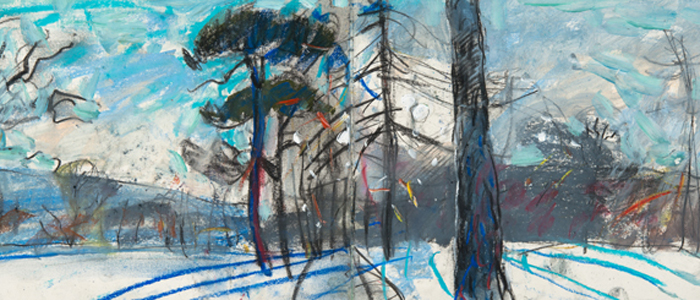
Introduction
"Working in harmony with nature in my notebooks has been an act of faith and an adventure which has taken me to and beyond the poetry of place on a personal odyssey."
Duncan Shanks, 2014.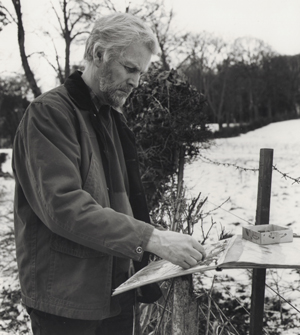 ‘The Poetry of Place’ celebrates Duncan Shanks’s major gift to the University of Glasgow of his entire output of sketchbooks from the past 55 years. With over 30 sketchbooks on view – never previously exhibited- it also presents the first major assessment of his artistic career. Further information on the collection is available in our Collections section.
‘The Poetry of Place’ celebrates Duncan Shanks’s major gift to the University of Glasgow of his entire output of sketchbooks from the past 55 years. With over 30 sketchbooks on view – never previously exhibited- it also presents the first major assessment of his artistic career. Further information on the collection is available in our Collections section.
Duncan Shanks (born 1937) is much admired in Scottish academic and art circles, though his reluctance to be involved with the social aspects of the art world and its institutions means he has remained largely unknown to the wider public. He has rarely shown his work outside Scotland and has mainly worked with two commercial art galleries, Roger Billcliffe Fine Art in Glasgow, and The Scottish Gallery in Edinburgh. In the last two decades, a number of exhibitions have highlighted Shanks’s ambition to capture through pictures inspired by his daily wanderings in his beloved Clyde valley not just space and atmosphere, but the passage of time and life’s transience.
The exhibition provides insight into Shanks’s approach to painting and his changing interpretations of the landscape he has known and loved throughout his life. The sketchbooks invite visitors to share the artist’s feeling of being part of Nature, and to explore his varying artistic processes, which can be driven by location, a desire to develop new methods of interpretation, or by the visual impact of a specific event.
A small group of accompanying works illustrate the varied use Shanks has made of the sketchbooks: larger scale drawings develop preliminary recordings; exploratory studies investigate more complex subjects; and more finished works show a final resolution. Photographs from the artist’s personal collection illustrate some of his favourite locations, from the immediate surroundings of his home at Crossford, a small village by the river Clyde, to the isolated glens and reservoirs of the Upper Clyde and the West coast and islands. In addition two paintings, Fragments of Memory, early 1990s and Night Garden, 1995-2007, generously gifted by the artist to complement the sketchbook collection, demonstrate the central role sketchbooks started to play in his work from the 1980s.
Header image: Sun through trees and snow, the Park, 1990s, pastel, watercolour, and compressed charcoal (GLAHA: 56447/46).
Duncan Shanks
"Painting, like nature, cannot be rushed and, working with landscape, I have learned to be patient. It is a journey which does not readily reveal its destination."
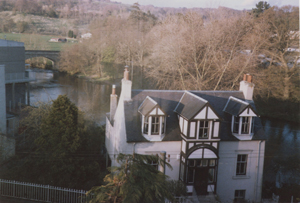 Duncan Shanks lives with his wife Una, a flower and still-life painter, in Crossford, some 20 miles south-east of Glasgow. The couple met at the Glasgow School of Art in 1960, and married six years later. When the newly-weds started looking for a home of their own, they dreamt of settling in the southern Hebrides. But reason prevailed, and they chose Davingill House in Crossford, with its old, broken-down orchard on a bend of the Clyde. Among its selling points was its location on the edge of the village, within easy reach of both town and remote countryside.
Duncan Shanks lives with his wife Una, a flower and still-life painter, in Crossford, some 20 miles south-east of Glasgow. The couple met at the Glasgow School of Art in 1960, and married six years later. When the newly-weds started looking for a home of their own, they dreamt of settling in the southern Hebrides. But reason prevailed, and they chose Davingill House in Crossford, with its old, broken-down orchard on a bend of the Clyde. Among its selling points was its location on the edge of the village, within easy reach of both town and remote countryside. 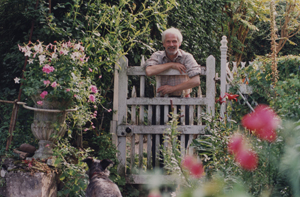 Furthermore it was only a 40 minute commute to the Glasgow School of Art where Shanks taught from 1961 to 1979, yet sufficiently removed to ensure a level of privacy. As the years went by, the colourful, complex, scented world they created within Davingill garden became a central part of their lives and a source of inspiration for both. Shanks absorbed himself in the Clyde valley, leaving it only for the occasional excursion to the West coast and islands, and frequent trips to Glasgow and Edinburgh since the artist is a regular concert-goer.
Furthermore it was only a 40 minute commute to the Glasgow School of Art where Shanks taught from 1961 to 1979, yet sufficiently removed to ensure a level of privacy. As the years went by, the colourful, complex, scented world they created within Davingill garden became a central part of their lives and a source of inspiration for both. Shanks absorbed himself in the Clyde valley, leaving it only for the occasional excursion to the West coast and islands, and frequent trips to Glasgow and Edinburgh since the artist is a regular concert-goer.
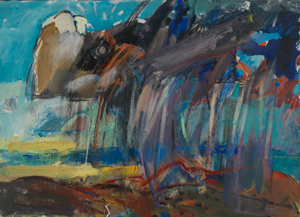 As the artist himself highlights, drawing has always been an addiction and a compulsion, a craving he has never managed to satisfy. He started filling sketchbooks in the 1960s, and once he resigned from his post at the Glasgow School of Art in 1979, they became an essential part of his creative process. To this day, Shanks tries to draw every day – it is a habit, a discipline, a way of forcing himself to look. The drawings and notes that have been accumulating in his sketchbooks over more than five decades ensure that his finished works are always firmly anchored to the landscape that inspires him, no matter how abstract shapes may become.
As the artist himself highlights, drawing has always been an addiction and a compulsion, a craving he has never managed to satisfy. He started filling sketchbooks in the 1960s, and once he resigned from his post at the Glasgow School of Art in 1979, they became an essential part of his creative process. To this day, Shanks tries to draw every day – it is a habit, a discipline, a way of forcing himself to look. The drawings and notes that have been accumulating in his sketchbooks over more than five decades ensure that his finished works are always firmly anchored to the landscape that inspires him, no matter how abstract shapes may become.
Locations and the Act of Drawing
"I have chosen, over the years, to work from the familiar landscape of the river and valley around my home. Knowing a landscape and its geography intimately through walking and drawing has let me concentrate immediately on that special moment which is different from anything that I have seen before."
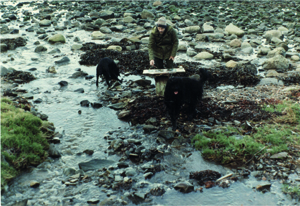 For Shanks, the physicality of the act of drawing in nature is paramount as it allows him to be part of nature and to experience it directly.
For Shanks, the physicality of the act of drawing in nature is paramount as it allows him to be part of nature and to experience it directly. 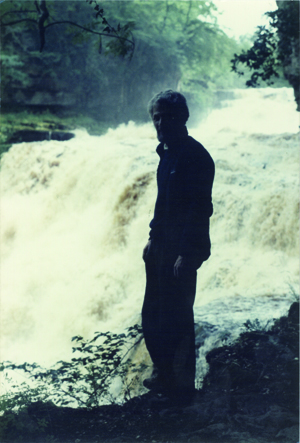 Perpetually driven, he ventures outside whatever the conditions. The obsessive intensity of the artist’s exploratory studies has involved lying on the ground, standing in the damp, in water, or under an umbrella as snow would fall, through the day and sometimes into the night – in short, to immerse himself fully, whatever the discomfort.
Perpetually driven, he ventures outside whatever the conditions. The obsessive intensity of the artist’s exploratory studies has involved lying on the ground, standing in the damp, in water, or under an umbrella as snow would fall, through the day and sometimes into the night – in short, to immerse himself fully, whatever the discomfort.
The ancient and unpopulated landscapes the artist is drawn to are often difficult to access. Storage places for boards and materials would be found near to favourite spots. For expeditions further afield, the boot of the car became a temporary studio store. 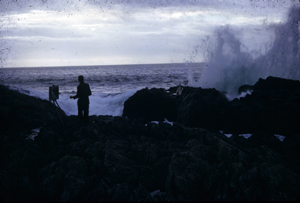 Each different location has what the artist refers to as ‘drawing stations’, or spots he would stop by whenever he was working there. A keen hiker, he has often used his climbing skills to reach these remote places, and equally relished the challenge of negotiating difficult terrain to reach a rewarding view or subject. Shanks vividly recalls jumping from one slippery boulder to another, or sitting on a rock in the middle of the Falls of Clyde, trekking through mud at Culter Fell, paddling up the river running through the steep Nethan Gorge, or finding refuge under a rocky outcrop on Tinto as bad weather closed in.
Each different location has what the artist refers to as ‘drawing stations’, or spots he would stop by whenever he was working there. A keen hiker, he has often used his climbing skills to reach these remote places, and equally relished the challenge of negotiating difficult terrain to reach a rewarding view or subject. Shanks vividly recalls jumping from one slippery boulder to another, or sitting on a rock in the middle of the Falls of Clyde, trekking through mud at Culter Fell, paddling up the river running through the steep Nethan Gorge, or finding refuge under a rocky outcrop on Tinto as bad weather closed in.
For Shanks this battle against the elements has always been an essential part of the creative process.
The Sketchbooks
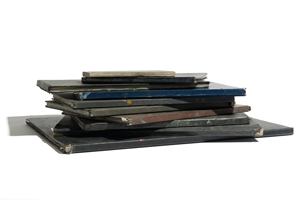 There are now 106 sketchbooks in The Hunterian, totalling more than 6500 drawings. A third are studies executed in the house or studio, linked in one way or another to his paintings – landscape or still-life. But most were executed outside, on the spot, and it is these drawings upon which this exhibition focuses. Honed by a lifetime of practice, they reflect the artist’s need to draw, which can be traced back to his routine at art school when painting in the day was followed by life-drawing classes in the evening.
There are now 106 sketchbooks in The Hunterian, totalling more than 6500 drawings. A third are studies executed in the house or studio, linked in one way or another to his paintings – landscape or still-life. But most were executed outside, on the spot, and it is these drawings upon which this exhibition focuses. Honed by a lifetime of practice, they reflect the artist’s need to draw, which can be traced back to his routine at art school when painting in the day was followed by life-drawing classes in the evening.
Inside the Sketchbooks
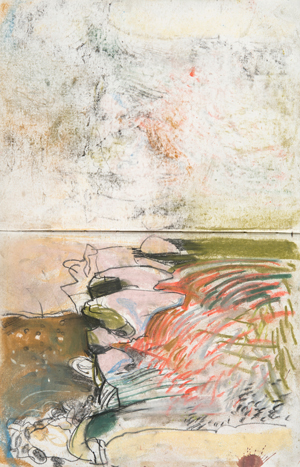 The earliest surviving sketchbook, taken on a study trip to Northern Italy in 1961, established the format of subsequent sketchbooks, with views down valleys, variations around a tree, effects of sun on landscape and buildings, and close-ups of intricate surface patterns.
The earliest surviving sketchbook, taken on a study trip to Northern Italy in 1961, established the format of subsequent sketchbooks, with views down valleys, variations around a tree, effects of sun on landscape and buildings, and close-ups of intricate surface patterns.
When the artist moved to Davingill House in 1967, he used his sketchbooks to familiarise himself with his new surroundings, making numerous notes on transient effects. Teaching part-time at the Glasgow School of Art, he would draw at the end of the day, or between painting sessions when a fresh-air break was needed to clear his mind.
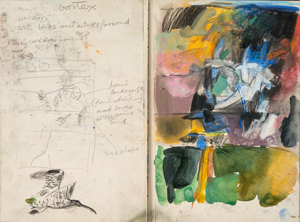 Over time, the sketchbooks became a vital tool with which to work out different approaches and, as the 1970s drew to an end, to develop a new pictorial vocabulary. Notes written in the studio started to appear in the smaller sketchbooks. Some record the artist’s thoughts in the moment, or verbalise what he was aiming to achieve visually. Others record the humdrum tasks of exhibition organisation, the selection of paintings, and the choice of frames.
Over time, the sketchbooks became a vital tool with which to work out different approaches and, as the 1970s drew to an end, to develop a new pictorial vocabulary. Notes written in the studio started to appear in the smaller sketchbooks. Some record the artist’s thoughts in the moment, or verbalise what he was aiming to achieve visually. Others record the humdrum tasks of exhibition organisation, the selection of paintings, and the choice of frames.
After resigning from his post at the School of Art in 1979, his sketching activity grew considerably: in the 1970s he had used just eight books, but since the 1980s he has filled an average of 20 to 30 per decade. This was a direct outcome of his new, full-time commitment to painting and of the growing importance of the sketchbooks as visual diaries of his daily thoughts and of the perambulations which were taking him further from home. Sequences of drawings, whether made in hours or days, started to appear. They reflect the importance for the artist of the repetition of the physical act and of the confidence that gradually builds as one drawing follows another.
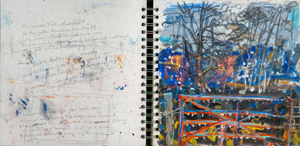 In his own words:
In his own words:
‘Hand and eye merge in an unforced rhythmic calligraphy. Ten or twenty drawings might be made in a session and I would often return, as the day developed, to rework earlier notes, hoping to intensify and strengthen their impact.’
From that point on, three different types of sketchbook can be identified. 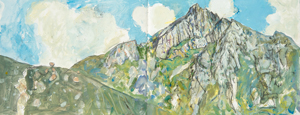 The first became about taking his raw material to the next level or finding solutions for paintings in progress. Such sketchbooks– which the artist refers to as ‘thinking books’ – tend to be smaller in size, and include numerous notes.
The first became about taking his raw material to the next level or finding solutions for paintings in progress. Such sketchbooks– which the artist refers to as ‘thinking books’ – tend to be smaller in size, and include numerous notes.
Among these are extracts from poetry and literature which convey the feelings and ideas with which he was currently working. They also document the development of a semi-abstract vocabulary inspired by places or objects with which Shanks was personally connected, or historical associations that made a particular landscape interesting to him.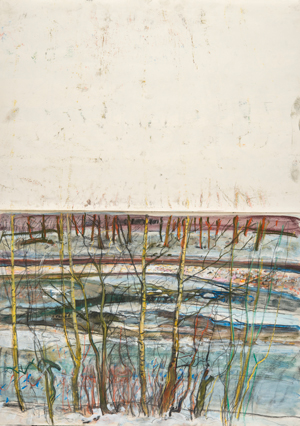
The two other types of sketchbooks remain mainly representational and are used on the spot. Larger in size and worked in mixed media, they are deployed to note anything that caught his eye while out in the landscape, or to investigate particular subjects in depth. They are characterised by an increased use of colour, reflecting Shanks’s move away from tonal thinking towards the more expressive qualities of colour.
Beyond the Sketchbooks
"Showing the sketchbooks alongside finished works can only hint at the depth of thought that lies between the starting point and the finished work, but at least it does do that and so gives us some idea of the richness of the creative process that produces such remarkable results."
Duncan Macmillan, Art Historian and Art Critic, 2014.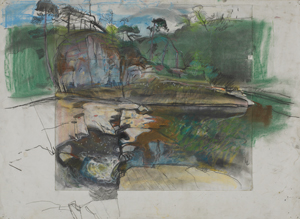
In order to illustrate the varied use he has made of his sketchbooks, Shanks has generously added a dozen works on paper and three finished paintings to his original gift to the University.
Among the works on paper are pages taken from sketchbooks, mounted and framed together to create an exhibition piece; collages made of notebook drawings that explore specific locations such as the Falls of Clyde; larger open air studies taking further specific potential subject matter; and studio drawings that show 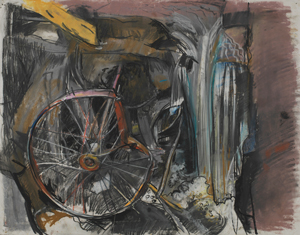 Shanks working towards the development of a semi-abstract pictorial vocabulary.
Shanks working towards the development of a semi-abstract pictorial vocabulary.
These are complemented in the exhibition by a small number of finished paintings,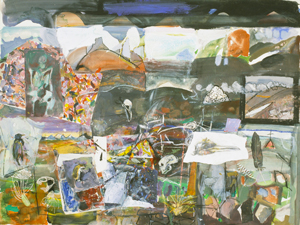 including Fragments of Memory, early 1990s, and Night Garden, 1995-2007.
including Fragments of Memory, early 1990s, and Night Garden, 1995-2007.
Fragments of Memory is an assemblage largely inspired by sketchbook drawings and by 20 years of walking up Tinto hill. It vividly illustrates the central role the sketchbooks started to play in Shanks’s paintings from the 1980s.
Night Garden belongs to a series of paintings inspired by the artist’s garden. As is often the case with Shanks’s paintings, 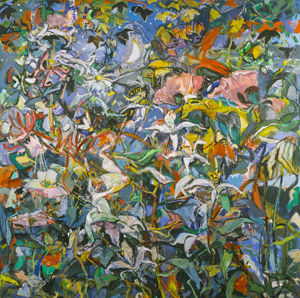 the idea behind its subject matter goes back to the early years of his career, in this instance his custom of sketching in the garden after a day’s teaching at the Glasgow School of Art, and his early interest in nocturnes.
the idea behind its subject matter goes back to the early years of his career, in this instance his custom of sketching in the garden after a day’s teaching at the Glasgow School of Art, and his early interest in nocturnes.
The first drawings specifically connected to Night Garden appear in sketchbooks dated 1994–5 of the garden and the Clyde valley. The next stage of the creative process can be traced through four subsequent sketchbooks. Although the first version of the painting was completed around 1997, other sketchbooks indicate the artist’s ongoing work on the subject, and reflect his painstaking approach often over many years, even decades before completing a painting.
Summary Chronology
Included are the most relevant group and solo exhibitions of the artist’s work.
| 1937 | Born, Airdrie, son of Duncan F. Shanks and Elizabeth Clark |
| 1955–60 | Studied at the Glasgow School of Art |
| 1959 | Hospitalfield summer school |
| 1960 | Post-graduate diploma and Travelling Scholarship to Italy |
| 1961 | Part time lecturer at the Glasgow School of Art |
| 1963 | Saw Soutine exhibition in Edinburgh |
| Holiday on Islay | |
| 1964 | Holiday on Tiree |
| 1966 | Married Una Gordon, a fellow artist and lecturer at Hamilton College of Education |
| Honeymoon on Tiree | |
| Saw the Bonnard retrospective exhibition, Royal Academy, London | |
| 1967 | Moved to Davingill House, Crossford |
| 1968 | Holiday in Torrisdale |
| Saw the Willem de Kooning exhibition at the Tate Gallery, London | |
| 1971 | Contribution to Art Spectrum Scotland, Scottish Arts Council Touring Exhibition |
| 1972 | Elected Associate of the Royal Scottish Academy |
| 1974 | First solo exhibition, Stirling University |
| 1975 | First contribution to a group exhibition 5 Glasgow Painters, Royal High School, Edinburgh |
| 1977 | Summer holiday in Majorca and first sketching session on Tinto |
| 1979 | Stopped teaching at the Glasgow School of Art and became full-time painter |
| 1981 | Duncan F. Shanks, The Scottish Gallery, Edinburgh |
| 1981–2 | Contribution to Contemporary Art from Scotland, Touring Exhibition organized by The Scottish Gallery, Edinburgh |
| Contribution to Scottish Painting, Toulouse | |
| Visited Paris and London, where he saw the Pablo Picasso retrospective at the Tate | |
| 1982 | Elected member of the Royal Glasgow Institute of Fine Arts |
| Summer holiday on the Mull of Kintyre | |
| Holidays in Ardnamurchan | |
| 1984 | Duncan Shanks Recent Works, The Fine Art Society, Glasgow and Edinburgh |
| Contribution to Weather, Scottish Arts Council Travelling Gallery | |
| Working winter at Culzean | |
| 1984–5 | Working at the Falls of Clyde |
| 1985 | Contribution to About Landscape, Edinburgh Festival Show, Talbot Rice Art Centre, University of Edinburgh |
| Contribution to Western Approaches, South West Galleries Association | |
| Contribution to Contemporary Scottish Art, Rio de Janeiro | |
| 1986 | Contribution to Ten Scottish Painters, The Upstairs Gallery, Royal Academy of Arts, London, organised by The Scottish Gallery, Edinburgh |
| 1987 | Elected member of the Royal Scottish Society of Painters in Watercolours |
| 1988 | Falling Water Variations on a Theme, Talbot Rice Art Centre, Crawford Centre, University of St Andrews; MacLaurin Art Gallery, Ayr |
| Contribution to The Scottish Show, Oriel 31 Touring Exhibition, Wales | |
| 1989 | Contribution to Ten contemporary Scottish painters, Thackeray Gallery, London |
| 1990 | Elected full member of the Royal Scottish Academy |
| Contemporary Art Season, Duncan Shanks, Kelvingrove Art Gallery, Glasgow | |
| 1991 | Commission: Coats Viyella – Tapestry woven by Edinburgh Tapestry Company, presented to Glasgow Royal Concert Hall |
| Contribution to Looking at Nature – Looking at Art – approaches to landscape, Dundee Art Galleries and Museums | |
| 1991–2 | Patterns of Flight, Wrexham Arts Centre Touring Exhibition |
| 1994 |
The Creative Process, Hunterian Art Gallery, University of Glasgow |
| 1994–6 | Working at the Nethan river |
| 1997 | Of Wet and of Wildness, The Scottish Gallery, Edinburgh |
| 1998 | Duncan Shanks Capriccios, Roger Billcliffe Gallery, Glasgow |
| 2000 | Holiday, Arran |
| 2001 | Holiday, Arran |
| 2002 | Duncan Shanks Beyond The Valley, Art London 2002, organised by The Scottish Gallery |
| 2003 | Contribution to Six RSA Artists, University of Central Florida |
| 2004 | Along an Overgrown Path, The Scottish Gallery, Edinburgh |
| 2006 | Air, Fire and Rain, Roger Billcliffe Gallery, Glasgow |
| 2007 | In a Summer Garden, The Scottish Gallery, Edinburgh |
| 2008 | Duncan Shanks, Art London 2008, organised by The Scottish Gallery, Edinburgh |
| 2009 | In Search of Past Time, The Scottish Gallery, Edinburgh |
| 2012 | Across a Painted Sky, The Scottish Gallery, Edinburgh |
| 2013 | Drawing the Year, The Scottish Gallery, Edinburgh |
Publication
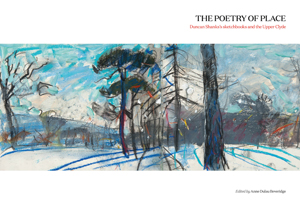 The Poetry of Place: The Upper Clyde Through Duncan Shanks Sketchbooks
The Poetry of Place: The Upper Clyde Through Duncan Shanks Sketchbooks
Edited by Anne Dulau Beveridge, with Duncan Shanks and Chris Allan
This fascinating publication accompanies the exhibition and is available from The Hunterian Art Gallery Shop at the special exhibition price of £13.99.
Events
Duncan Shanks Salon des Refusés
Wednesday 18 March 2015
2.00pm – 3.00pm
Hunterian Art Gallery
Admission free - booking required
A rare chance to see behind the scenes at the Hunterian Art Gallery. At this special curator-led event, participants will see items from our Duncan Shanks collection that are not included in the exhibition.
Please note, this event is now fully booked.
Hunterian Insight Talk
Duncan Shanks: Materials and Techniques
Tuesday 24 March 2015
1.00pm - 1.15pm
Hunterian Art Gallery
Admission free
Former Hunterian Deputy Director Chris Allan will talk about Duncan Shanks materials and techniques.
Hunterian Insight Talk
Messages in the Landscape in the art of Duncan Shanks
Tuesday 5 May 2015
1.00pm - 1.15pm
Hunterian Art Gallery
Admission free
Professor Paul Bishop from the University of Glasgow will talk about messages in the landscape in relation to Duncan Shanks.
Hunterian Friends Curator's Insight: Duncan Shanks
Monday 11 May 2015
2.00pm – 4.00pm
Hunterian Art Gallery
Tickets: £20.00 per Friend - limited to 10 people
At this intimate event, Hunterian curator Anne Dulau Beveridge will give Friends a personal tour of the special focus exhibition Duncan Shanks Sketchbooks, offering expert insight.
Centre for Open Studies Study Session: Duncan Shanks
Wednesday 8 July 2015
10.00am - 12.00 noon
Hunterian Art Gallery
A special two hour session in conjunction with the Centre for Open Studies. Includes a talk in The Hunterian Art Gallery Lecture Theatre which will provide insight into the preparation of the Duncan Shanks Sketchbooks exhibition, using material gathered over six years by exhibition curator Anne Dulau Beveridge. Followed by a tour of the exhibition. Booking details to follow.
Acknowledgements
Particular thanks are due to Duncan and Una Shanks and to Chris Allan, for their assistance in the preparation of the exhibition and its accompanying publication, ‘The Poetry of Place’ The Upper Clyde through Duncan Shanks’s sketchbooks. Camilla Athayde, and University of Glasgow work placement students Ana Szilagyi, Alyssa Hoff and Lesley Jennifer Neason, made valued contributions to the cataloguing and photography of the sketchbooks. The supporting film was prepared by the University of Glasgow’s Media Production Unit.

